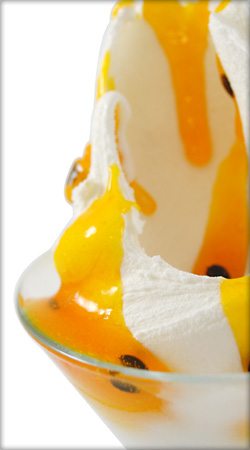
 This subtropical treat is a hot fruit these days, inspiring all walks of the culinary world including everything from tropical cake fillings to sorbets and even savory dishes.
This subtropical treat is a hot fruit these days, inspiring all walks of the culinary world including everything from tropical cake fillings to sorbets and even savory dishes.
Vibrant colors and assorted textures from all kinds of domestic and exotic fruit are popping up more and more every time you scour the produce section of your favorite grocery store, and for good reason. Consumers are expanding well beyond their normal repertoire of foods to include unique and different fruits in their diet. Amidst the rainbow of healthy produce out there, one small, egg-shaped fruit tends to stand out with its thick, hard-looking skin – the passion fruit. This subtropical treat is a hot fruit these days, inspiring all walks of the culinary world including everything from tropical cake fillings to sorbets and even savory dishes. And though its popularity is growing, it is still a virtually unknown fruit to many, so let’s take a closer look.
To people who are unacquainted with the unique appearance of a ripe passion fruit, or granadilla, it may seem plausible to assume that the native South American crop is rotten due to its dull luster and wrinkled, dimpled skin. However, the more fermented the appearance, the sweeter the passion fruit actually tastes. By slicing the oblong fruit lengthwise, you will discover a stimulating scent as well as a seedy, pungently sweet, gelatinous pulp with a brilliant yellow-orange hue.
Currently there are over 500 known variations of Passiflora edulis, but the plum-sized purple and the grapefruit-sized yellow passion fruit are the most widely cultivated in America, namely from Hawaii and California. Despite the popularity of both, the purple passion fruit is less acidic and sweeter than its yellow cousin when fully ripe. It also has a juicier pulp, which makes the purple fruit more sought-after for culinary use.
In addition to the delicious contributions of flavor that passion fruit gives to everything from jam to gelato, it is also overflowing with a wealth of nutrients and other healthful benefits. According to documented scientific research, the leaves of the Passiflora edulis contain sleep-inducing compounds that help the body relax and rest easier, and the flowers can be used to treat gastrointestinal ailments as well as anxiety. Moreover, the strong presence of antioxidants in the passion fruit can help inhibit the growth of cancer cells and protect the human heart against coronary disease. This small, fiber-rich food also collectively offers vitamins A, B and C, as well as iron and calcium, and plays an important role in sustaining good vision while boosting the immune system and building strong bones. Furthermore, passion fruit counters histamines produced by the body that react to allergens, thereby suppressing allergy properties, as well as those of asthma. As an added bonus, the soft, edible seeds and refreshing pulp help to promote healthy digestion.
Describable as tasty, healthy, interesting, medicinal and even unattractive by virtue of its outside appearance, it is clear that despite the uninspiring appearance of passion fruit, it’s one fruit to watch in the world of culinary arts.
References:
Fruit Health Benefits Passion Fruit Nutrition Retrieved March 2011
www.fruithealthbenefits.com/passion-fruit-nutrition.shtml
Power Your Diet www.nutrition-and-you.com your guide to healthier nutrition
Passion Fruit Nutrition Facts Retrieved March 2011 www.nutrition-and-you.com/passion-fruit.html
Passion Fruit Retrieved March 2011 www.crfg.org/pubs/ff/passionfruit.html
